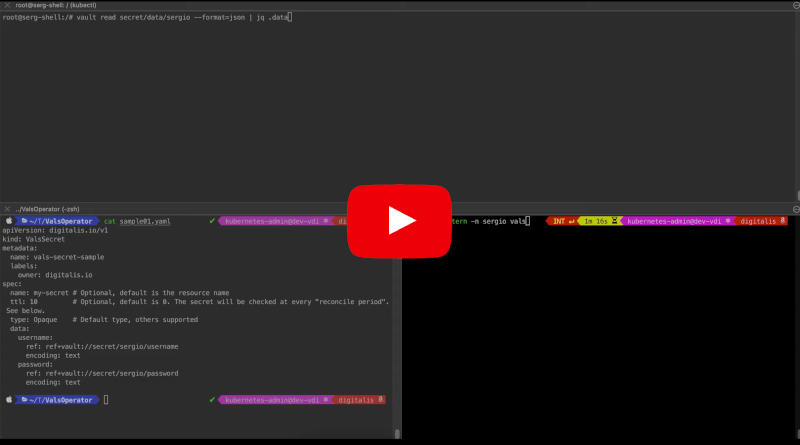Here at Digitalis we love vals, it's a tool we use daily to keep secrets stored securely. We also use secrets-manager on the Kubernetes deployment we manage. Inspired by these two wonderful tools we have created this operator.
vals-operator syncs secrets from any secrets store supported by vals into Kubernetes. It works very similarly to secrets-manager and the code is actually based on it. Where they differ is that it not just supports HashiCorp Vault but many other secrets stores.
You can watch this brief video on how it works:
We have also added the ability to copy secrets between namespaces. It uses the format ref+k8s://namespace/secret#key. This way you can keep secrets generated in one namespace in sync with any other namespace in the cluster.
You can use the helm chart to install vals-operator. First of all, add the repository to your helm installation:
helm repo add digitalis https://digitalis-io.github.io/helm-chartsYou will need to provide the configuration to access the secrets store you decided on via either environment variables pre existing secrets.
# Example for Vault
helm upgrade --install vals-operator --create-namespace -n vals-operator \
--set "env[0].name=VAULT_ROLE_ID,env[0].value=vals-operator" \
--set "env[1].name=VAULT_SECRET_ID,env[1].value=my-secret-id" \
--set "env[2].name=VAULT_ADDR,env[2].value=https://vault:8200"
digitalis/vals-operator
# Example for AWS using a secret
kubectl create secret generic -n vals-operator aws-creds \
--from-literal=AWS_ACCESS_KEY_ID=foo \
--from-literal=AWS_SECRET_ACCESS_KEY=bar \
--from-literal=AWS_DEFAULT_REGION=us-west-2
helm upgrade --install vals-operator --create-namespace -n vals-operator \
--set "secretEnv[0].secretRef.name=aws-creds" \
digitalis/vals-operator
# Another example using a Google Cloud service account
kubectl create secret generic -n vals-operator google-creds \
--from-file=credentials.json=/path/to/service_account.json
helm upgrade --install vals-operator --create-namespace -n vals-operator \
--set "env[0].name=GOOGLE_APPLICATION_CREDENTIALS,env[0].value=/secret/credentials.json" \
--set "env[1].name=GCP_PROJECT,env[1].value=my_project" \
--set "volumes[0].name=creds,volumes[0].secret.secretName=google-creds" \
--set "volumeMounts[0].name=creds,volumeMounts[0].mountPath=/secret" \
digitalis/vals-operatorVals-Operator is also available to install from the Rancher Marketplace.
If you're using Vault as backend you can also enable the Kubernetes Auth login method. Refer to the HashiCorp documentation on creating a role.
You will need to add two additional environment variables to the vals-operator installation:
- VAULT_ROLE_ID: required to enable Kubernetes Login
- VAULT_ADDR: URL to the Vault server, ie, http://vault:8200
- VAULT_LOGIN_USER and VAULT_LOGIN_PASSWORD: to use
userpassauthentication (insecure, not recommended) - VAULT_APP_ROLE and VAULT_SECRET_ID: to use
approleauthentication
apiVersion: digitalis.io/v1
kind: ValsSecret
metadata:
name: vals-secret-sample
labels:
owner: digitalis.io
spec:
name: my-secret # Optional, default is the resource name
ttl: 3600 # Optional, default is 0. The secret will be checked at every "reconcile period". See below.
type: Opaque # Default type, others supported
data:
username:
ref: ref+vault://secret/database/username
encoding: text
password:
ref: ref+vault://secret/database/password
encoding: text
ssh:
ref: ref+vault://secret/database/ssh-private-key
encoding: base64
aws-user:
ref: ref+awssecrets://kube/test#username
aws-pass:
ref: ref+awssecrets://kube/test#password
ns-secret:
ref: ref+k8s://namespace/secret#keyThe example above will create a secret named my-secret and get the values from the different sources. The secret will be kept in sync against the backed secrets store.
The TTL is optional and used to decrease the number of times the operator calls the backend secrets store as some of them such as AWS Secrets Manager will incur a cost.
The default encoding is text but you can change it to base64 per secret reference. This way you can, for example, base64 encode large configuration files.
If you're running a database you may want to keep the secrets in sync between your secrets store, Kubernetes and the database. This can be handy for password rotation to ensure the clients don't use the same password all the time. Please be aware your client must suppport re-reading the secret and reconnecting whenever it is updated.
We don't yet support TLS, we'll add it to future releases.
---
apiVersion: digitalis.io/v1
kind: ValsSecret
metadata:
name: vals-secret-sample
labels:
owner: digitalis.io
spec:
name: my-secret # Optional, default is the resource name
ttl: 10 # Optional, default is 0. The secret will be checked at every "reconcile period". See below.
type: Opaque # Default type, others supported
data:
username:
ref: ref+gcpsecrets://databases/test#username
encoding: text
password:
ref: ref+gcpsecrets://databases/test#password
encoding: text
databases:
- driver: cassandra
loginCredentials:
secretName: cassandra-creds # secret containing the username and password to access the DB and run the below query
usernameKey: username # in the secret, which key contains the username (default `cassandra`)
passwordKey: password # in the secret, which key contains the password
port: 9042
usernameKey: username
passwordKey: password
hosts: # list all your cassandra nodes here
- cassandra01
- cassandra02
- driver: postgres
loginCredentials:
secretName: postgres-creds
usernameKey: username
passwordKey: password
port: 5432
usernameKey: username
passwordKey: password
hosts:
- postgres
- driver: mysql
loginCredentials:
secretName: mysql-creds
namespace: mysql-server
passwordKey: mysql-root-password # if username is omitted it defaults to `mysql`
port: 3306
usernameKey: username
passwordKey: password
userHost: "%" # default
hosts:
- mysql
- driver: elastic
loginCredentials:
secretName: elastic-creds
namespace: elastic-server
usernameKey: username # the username defaults to 'elastic' if not provided
passwordKey: password
port: 9200
usernameKey: username
passwordKey: password
hosts:
- my-elastic # this would be converted to http://my-elastic:9200
- https://my-other-elastic:9200 # provide full URL insteadThe following options are available. See the helm chart documentation for more information on adding them to your deployment configuration.
Usage of ./bin/vals-operator:
-exclude-namespaces string
Comma separated list of namespaces to ignore.
-health-probe-bind-address string
The address the probe endpoint binds to. (default ":8081")
-kubeconfig string
Paths to a kubeconfig. Only required if out-of-cluster.
-leader-elect
Enable leader election for controller manager. Enabling this will ensure there is only one active controller manager.
-metrics-bind-address string
The address the metric endpoint binds to. (default ":8080")
-reconcile-period duration
How often the controller will re-queue vals-operator events. (default 5s)
-record-changes
Records every time a secret has been updated. You can view them with kubectl describe. It may also be disabled globally and enabled per secret via the annotation 'vals-operator.digitalis.io/record: "true"' (default true)
-ttl duration
How often to check backend for updates. (default 5m0s)
-watch-namespaces string
Comma separated list of namespaces that vals-operator will watch.
-zap-devel
Development Mode defaults(encoder=consoleEncoder,logLevel=Debug,stackTraceLevel=Warn). Production Mode defaults(encoder=jsonEncoder,logLevel=Info,stackTraceLevel=Error) (default true)
-zap-encoder value
Zap log encoding (one of 'json' or 'console')
-zap-log-level value
Zap Level to configure the verbosity of logging. Can be one of 'debug', 'info', 'error', or any integer value > 0 which corresponds to custom debug levels of increasing verbosity
-zap-stacktrace-level value
Zap Level at and above which stacktraces are captured (one of 'info', 'error', 'panic').


